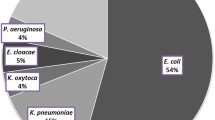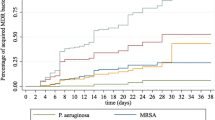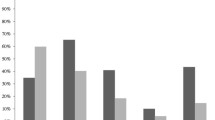Abstract
Evaluating trends in antibiotic resistance is a requisite. The study aimed to analyze the profile of multidrug-resistant organisms (MDROs) among hospitalized patients with bacteremia in intensive care units (ICUs) in a large geographical area. This is a 1-month cross-sectional survey for blood-borne pathogens in 57 ICUs from 24 countries with different income levels: lower-middle-income (LMI), upper-middle-income (UMI), and high-income (HI) countries. Multidrug-resistant (MDR), extensively drug-resistant (XDR), or pan-drug-resistant isolates were searched. Logistic regression analysis determined resistance predictors among MDROs. Community-acquired infections were comparable to hospital-acquired infections particularly in LMI (94/202; 46.5% vs 108/202; 53.5%). Although MDR (65.1%; 502/771) and XDR (4.9%; 38/771) were common, no pan-drug-resistant isolate was recovered. In total, 32.1% of MDR were Klebsiella pneumoniae, and 55.3% of XDR were Acinetobacter baumannii. The highest MDR and XDR rates were in UMI and LMI, respectively, with no XDR revealed from HI. Predictors of MDR acquisition were male gender (OR, 12.11; 95% CI, 3.025–15.585) and the hospital-acquired origin of bacteremia (OR, 2.643; 95%CI, 1.462–3.894), and XDR acquisition was due to bacteremia in UMI (OR, 3.344; 95%CI, 1.189–5.626) and admission to medical-surgical ICUs (OR, 1.481; 95% CI, 1.076–2.037). We confirm the urgent need to expand stewardship activities to community settings especially in LMI, with more paid attention to the drugs with a higher potential for resistance. Empowering microbiology laboratories and reports to direct prescribing decisions should be prioritized. Supporting stewardship in ICUs, the mixed medical-surgical ones in particular, is warranted.


Similar content being viewed by others
References
CDC (2013) Antibiotic resistant threats in the United States. https://www.cdc.gov/drugresistance/pdf/ar-threats-2013-508.pdf. Accessed [2nd Apr 2020]
Erdem H, Inan A, Altindis S, Carevic B, Askarian M, Cottle L et al (2014) Surveillance, control and management of infections in intensive care units in Southern Europe, Turkey and Iran - a prospective multicenter point prevalence study. J Infect 68:131–140. https://doi.org/10.1016/j.jinf.2013.11.001
Health Research & Educational Trust (2017) Multi-drug resistant organism infection change package: 2017 update. Chicago: Health Research & Educational Trust [Internet]. 2017. www.hret-hiin.org
Hope D, Ampaire L, Oyet C, Muwanguzi E, Twizerimana H, Apecu RO (2019) Antimicrobial resistance in pathogenic aerobic bacteria causing surgical site infections in Mbarara regional referral hospital. Southwestern Uganda Sci Rep 29:17299
Keizer J, Braakman-Jansen LMA, Kampmeier S, Köck R, Al Naiemi N, Te Riet-Warning R, et al (2019) Cross-border comparison of antimicrobial resistance (AMR) and AMR prevention measures: the healthcare workers’ perspective. Antimicrob Resist Infect Control 8. https://doi.org/10.1186/s13756-019-0577-4
Barlam TF, Cosgrove SE, Abbo LM, Macdougall C, Schuetz AN, Septimus EJ et al (2016) Implementing an antibiotic stewardship program: guidelines by the Infectious Diseases Society of America and the Society for Healthcare Epidemiology of America. Clin Infect Dis 62:e51-77. https://doi.org/10.1093/cid/ciw118
Klein EY, Tseng KK, Pant S, Laxminarayan R (2019) Tracking global trends in the effectiveness of antibiotic therapy using the Drug Resistance Index. BMJ Glob Heal 4:e001315. https://doi.org/10.1136/bmjgh-2018-001315
Updated country income classifications for the World Bank’s 2020 fiscal year (2020) https://datahelpdesk.worldbank.org/knowledgebase/articles/906519-world-bank-country-and-lending-groups Accessed [2 Feb 2020] [Internet]. https://datahelpdesk.worldbank.org/knowledgebase/articles/906519-world-bank-country-and-lending-groups Accessed [2 Feb 2020]
Magiorakos AP, Srinivasan A, Carey RB, Carmeli Y, Falagas ME, Giske CG et al (2012) Multidrug-resistant, extensively drug-resistant and pandrug-resistant bacteria: an international expert proposal for interim standard definitions for acquired resistance. Clin Microbiol Infect [Internet] 18:268–281. https://doi.org/10.1111/j.1469-0691.2011.03570.x
Courjon J, Demonchy E, Degand N, Risso K, Ruimy R, Roger PM (2017) Patients with community-acquired bacteremia of unknown origin: clinical characteristics and usefulness of microbiological results for therapeutic issues: a single-center cohort study. Ann Clin Microbiol Antimicrob 16. https://doi.org/10.1186/s12941-017-0214-0
CDC (2020) Multidrug-resistant organism & Clostridioides difficile infection (MDRO/CDI) Module. https://www.cdc.gov/nhsn/PDFs/pscManual/12pscMDRO_CDADcurrent.pdf [2nd Apr 2020]
Rawat D, Nair D (2010) Extended-spectrum ß-lactamases in gram negative bacteria. J Glob Infect Dis 2:263. https://doi.org/10.4103/0974-777x.68531
Weinshel K, Dramowski A, Hajdu Á, Jacob S, Khanal B, Zoltán M et al (2015) Gap analysis of infection control practices in low- and middle-income countries. Infect Control Hosp Epidemiol 36:1208–1214. https://doi.org/10.1017/ice.2015.160
Erdem H, Hargreaves S, Ankarali H, Caskurlu H, Alkan-Ceviker S, Bahar-Kacmaz A et al (2021) Managing adult patients with infectious diseases in emergency departments: international ID-IRI study. J Chemother. https://doi.org/10.1080/1120009X.2020.1863696
Rosenthal VD, Maki DG, Mehta Y, Leblebicioglu H, Memish ZA, Al-Mousa HH et al (2014) International Nosocomial Infection Control Consortium (INICC) report, data summary of 43 countries for 2007–2012. Device-associated module Am J Infect Control 42:942–956. https://doi.org/10.1016/j.ajic.2014.05.029
Lim C, Takahashi E, Hongsuwan M, Wuthiekanun V, Thamlikitkul V, Hinjoy S et al (2016) Epidemiology and burden of multidrug-resistant bacterial infection in a developing country. Elife 5:1–18. https://doi.org/10.7554/eLife.18082
Zilahi G, Artigas A, Martin-Loeches I (2016) What’s new in multidrug-resistant pathogens in the ICU? Ann Intensive Care 6. https://doi.org/10.1186/s13613-016-0199-4
WHO Antibiotic Categorization (2020) https://aware.essentialmeds.org/list. Last accessed 22nd Dec
Tabah A, Koulenti D, Laupland K, Misset B, Valles J, Bruzzi De Carvalho F et al (2012) Characteristics and determinants of outcome of hospital-acquired bloodstream infections in intensive care units: The EUROBACT International Cohort Study. Intensive Care Med 38:1930–1945. https://doi.org/10.1007/s00134-012-2695-9
El-Sokkary RH, Negm EM, Othman HA, Tawfeek MM, Metwally WS (2020) Stewardship actions for device associated infections: an intervention study in the emergency intensive care unit. J Infect Public Health [Internet] 13:1927–1931. https://doi.org/10.1016/j.jiph.2020.10.003
Forde CA, Martindale Y, Patel S (2019) The real scenario in infection prevention and control in low- and middle-income countries: the challenge of “starting from scratch.” Curr Treat Options Infect Dis 11:281–291. https://doi.org/10.1007/s40506-019-00196-3
Wang L, Huang X, Zhou J, Wang Y, Zhong W, Yu Q, et al (2020) Predicting the occurrence of multidrug-resistant organism colonization or infection in ICU patients: development and validation of a novel multivariate prediction model. Antimicrob Resist Infect Control 9. https://doi.org/10.1186/s13756-020-00726-5
Mascitti H, Duran C, Nemo EM, Bouchand F, Câlin R, Descatha A, et al (2018) Factors associated with bacteraemia due to multidrug-resistant organisms among bacteraemic patients with multidrug-resistant organism carriage: a case control study 11 Medical and Health Sciences 1103 Clinical Sciences. Antimicrob Resist Infect Control 7. https://doi.org/10.1186/s13756-018-0412-3
Goodman KE, Lessler J, Cosgrove SE, Harris AD, Lautenbach E, Han JH et al (2016) A Clinical decision tree to predict whether a bacteremic patient is infected with an extended-spectrum β-lactamase-producing organism. Clin Infect Dis 63:896–903. https://doi.org/10.1093/cid/ciw425
Tosi M, Roat E, De Biasi S, Munari E, Venturelli S, Coloretti I et al (2018) Multidrug resistant bacteria in critically ill patients: a step further antibiotic therapy. J Emerg Crit Care Med 2:103–103. https://doi.org/10.21037/jeccm.2018.11.08
Erdem H, Turkan H, Cilli A, Karakas A, Karakurt Z, Bilge U et al (2013) Mortality indicators in community-acquired pneumonia requiring intensive care in Turkey. Int J Infect Dis 17:e768–e772. https://doi.org/10.1016/j.ijid.2013.03.015
Erdem H, Cag Y, Gencer S, Uysal S, Karakurt Z, Harman R et al (2020) Treatment of ventilator-associated pneumonia (VAP) caused by Acinetobacter: results of prospective and multicenter ID-IRI study. Eur J Clin Microbiol Infect Dis 39:45–52. https://doi.org/10.1007/s10096-019-03691-z
Author information
Authors and Affiliations
Corresponding author
Ethics declarations
Ethical approval
Yes, it is obtained from Trabzon Kanuni Hospital’s Review Board.
Informed consent
Obtained.
Conflict of interest
The authors declare no competing interests.
Additional information
Publisher's Note
Springer Nature remains neutral with regard to jurisdictional claims in published maps and institutional affiliations.
Rights and permissions
About this article
Cite this article
El-Sokkary, R., Uysal, S., Erdem, H. et al. Profiles of multidrug-resistant organisms among patients with bacteremia in intensive care units: an international ID-IRI survey. Eur J Clin Microbiol Infect Dis 40, 2323–2334 (2021). https://doi.org/10.1007/s10096-021-04288-1
Received:
Accepted:
Published:
Issue Date:
DOI: https://doi.org/10.1007/s10096-021-04288-1




